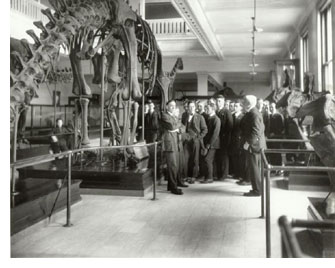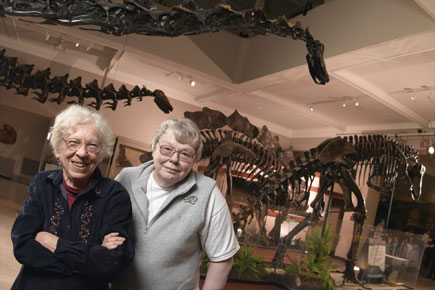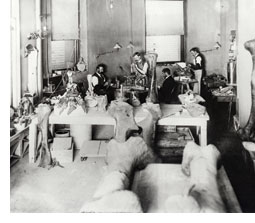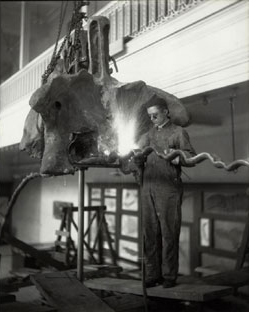COLOSSAL!
By M.A. Jackson
Its creation
more than a century ago was called a “colossal undertaking,”
and its residents were the most colossal creatures ever
to have roamed the earth. Dinosaur Hall: a history.
In 1898, three years after opening Carnegie Museums, Andrew
Carnegie asked museum Director William Holland to purchase
a dinosaur for display. Holland accepted the challenge while
warning his boss that buying, transporting, and mounting
such a specimen would be “the most colossal undertaking
of its kind in the history of
the world.”
Now, more than a century later, Carnegie Museum of Natural
History is about to embark on another colossal project:
updating and expanding its venerable and beloved Dinosaur
Hall. The project is no less ambitious than Andrew
Carnegie’s dream of creating a home for prehistoric
creatures in the dusty steel town where he made his fortune.
It will go beyond the mere presentation of dinosaur skeletons,
however, as it places the skeletal remains of dinosaurs,
mammals, fish, and the plant life from the Age of Dinosaurs
in realistic environments and scientifically accurate positions.
Groundbreaking is scheduled for March 2005.
 “Carnegie
intrinsically understood the appeal of the dinosaurs and
how the public would react,” says Bill DeWalt, director
of Carnegie Museum of Natural History. “He knew dinosaurs
would bring people in, and he wanted his museum to be to
be the center of scientific research about dinosaurs and
their world.” “Carnegie
intrinsically understood the appeal of the dinosaurs and
how the public would react,” says Bill DeWalt, director
of Carnegie Museum of Natural History. “He knew dinosaurs
would bring people in, and he wanted his museum to be to
be the center of scientific research about dinosaurs and
their world.”
Right: What Andrew
Carnegie wanted, he got—and he wanted a dinosaur.
Here, then-museum Director William Holland gives dignitaries
a look at Diplodocus carnegii.
“Carnegie was of the ‘Oh my!’ value of
things,” says Mary Dawson, curator emeritus with Carnegie
Museum of Natural History. And no matter how jaded we think
we’ve become, the spectacle of a roomful of dinosaurs
never ceases to impress us.
“I’ve seen parents literally dash through the
other rooms in the museum with their children—they
just want to see the dinosaurs,” says Dawson, who
retired in 2003 after 30 years as the museum’s curator
of Vertebrate Paleontology, although she’s still active
in research. Surprisingly, the woman who has spent a good
part of her career talking about dinosaurs isn’t a
dinosaur expert at all. Her field of expertise is fossil
mammals. “I’ve never done research on a dinosaur,”
she says. “But dinosaurs are an occupation here for
any curator because of the public interest and the collections.”
For the Love of
Dinosaurs
As a child, John “Jack” McIntosh was one of
those kids who would race by other exhibits to see the dinosaurs.
A Wesleyan University physics professor emeritus, McIntosh
remembers the first time he visited Dinosaur Hall
at age five. “I fell in love immediately,” he
says.
As a teenager in the 1930s, McIntosh visited the museum’s
Paleontology department regularly—even during vacations—getting
to know the staff and the collections. Even though a Yale
professor convinced him to go into a field where he’d
earn more money, McIntosh continued to study the dinosaurs.
Today he is considered one of the world’s foremost
experts on sauropods (plant-eating dinosaurs with long necks
and tails), such as the museum’s Diplodocus carnegii.
Dinosaurs have enthralled people of all ages since they
were first discovered in the mid-1800s, and Carnegie was
no exception. The combination of the animals being a relatively
new phenomena, extremely rare, and colossal in size was
an intoxicating mixture for the industrialist.
“Carnegie always wanted the latest thing,” says
Betty Hill, retired collections archivist and now a volunteer
with the Museum of Natural History.
It was while visiting New York City that Carnegie opened
the newspapers to articles touting the Wyoming discovery
of a Brontosaurus giganteus. Carnegie immediately
sent the New York Post article to William Holland, with
a note “can you buy this for Pittsburgh—try…get
an offer...hurry.” Hill has the note, and many others,
scanned into the archives that she continues to painstakingly
fill.
Hill, who was hired by Mary Dawson in 1975 to help archive
the museum’s vast collections, probably knows the
story of Carnegie’s dinosaurs better than anyone,
having spent the last three years electronically storing
countless documents into the museum’s archives, including
old letters from Carnegie to his staff.

With a wealth
of knowledge and experience between them are Mary Dawson
(left), curator of Vertebrate Paleontology for over three
decades and now curator emeritus, and Betty Hill, retired
collection manager, whose association with the Museum of
Natural History has spanned 30 years.
PHOTO: RIC EVANS
Pay Dirt
Holland, always eager to please his boss, did hurry—fulfilling
Carnegie’s request within a year.
He spent the first six months trying to buy Brontosaurus
giganteus—which later turned out to be only a
femur. Finally admitting defeat, Holland moved his bone-digging
team 20 miles away to another site in the Morrison Formation
in Wyoming, hoping to find another dinosaur. On July 4,
1899, they hit pay dirt. In the months and years ahead,
they would send so many crates of fossils to Pittsburgh—including
the bones of three partial Diplodocus specimens—that
the museum installed railway tracks in its basement to facilitate
delivery.
 Left:
Earl Douglas, Carnegie bone hunter, at work. Left:
Earl Douglas, Carnegie bone hunter, at work.
Before becoming director of Carnegie Museums, Holland,
a Princeton graduate proficient in several languages, had
been pastor of Oakland’s Bellefield Presbyterian Church
and chancellor of Western University of Pennsylvania (now
the University of Pittsburgh). While he was self-taught
in paleontology, Holland had a thirst for scientific knowledge.
“Holland learned an awful lot,” says McIntosh.
“His later papers were quite good.” Dawson adds
that while Carnegie had the funds, Holland “was important
in understanding what was found.” What’s more,
Holland used Carnegie’s money to recruit major talent,
including Arthur Coggeshall, a fossil preparator, and Jacob
Wortman, the museum’s first curator of Vertebrate
Paleontology—both hired away from the American Museum
in New York. “Holland got a very fine staff of very
experienced men,” says McIntosh. “Coggeshall
was one of the best preparators of his time.”
When Wortman left the museum in 1900, Holland hired Princeton
Paleonto-logist John Bell Hatcher, who invented the excavation
grid system still used by paleontologists in the discovery
and study of dinosaur fossils. “Hatcher was a very,
very fine paleontologist,” says McIntosh.
It was Hatcher who dubbed the Carnegie team’s first
major find—a colossal sauropod—Diplodocus
carnegii “in recognition of Carnegie’s
interest in vertebrate paleontology.” The longest
known dinosaur at the time (its reign was later usurped
by Brachiosaurus), the Diplodocus is a
type specimen—the first of its kind found and the
basis for the species’ original description.
 While
the $5 million museum expansion to house the dinosaur was
underway, King Edward VII saw an illustration of Diplodocus
carnegii and requested that Carnegie find one for the
British Museum. Knowing such a task would be nearly impossible,
Carnegie offered the king a Diplodocus carnegii
cast. Once mounted in England—two years before the
original would debut in Pittsburgh—requests poured
in. As a gesture of goodwill and scientific cooperation,
Carnegie (and later his wife) gave casts of his namesake
to 12 museums around the world, making Diplodocus carnegii
one of the world’s most seen dinosaurs. While
the $5 million museum expansion to house the dinosaur was
underway, King Edward VII saw an illustration of Diplodocus
carnegii and requested that Carnegie find one for the
British Museum. Knowing such a task would be nearly impossible,
Carnegie offered the king a Diplodocus carnegii
cast. Once mounted in England—two years before the
original would debut in Pittsburgh—requests poured
in. As a gesture of goodwill and scientific cooperation,
Carnegie (and later his wife) gave casts of his namesake
to 12 museums around the world, making Diplodocus carnegii
one of the world’s most seen dinosaurs.
All the casts, as well as the originals, were mounted using
an ingenious system created by Coggeshall in which dinosaur
vertebrae are strung along one iron rod—using Carnegie
steel, naturally. Bones were attached with steel as unobtrusively
as possible. Mary Dawson says the mounting “is a work
of art itself.”
Bones, Bones,
and More Bones
In 1909, thanks to Carnegie’s annual $10,000 add-on
to the museum’s paleontology budget, Paleontologist
Earl Douglass—often referred to as “the King
of Collectors”—discovered one of the largest
caches of dinosaur bones ever found in the Morrison Formation
near Jensen, Utah. Designated Dinosaur National Monument
in 1919, the site contained enough dinosaur bones to keep
crews excavating year-round for 13 years.
Of the 20 mountable skeletons found, six were erected in
Dinosaur Hall between 1915 and the early 1940s:
Apatosaurus louisae (a.k.a. bronto-saurus),
Dryosaurus altus, Allosaurus fraglisi, a juvenile
Camarasaurus (the most complete sauropod skeleton
ever found), Stegosaurus ungulatus, and Camptosaurus
dispar. The Apatosaurus louisae, a type specimen,
was named after Carnegie’s wife, Louise. A more unusual
gift from a husband to his wife is difficult to imagine.
 Also
difficult to imagine is what Carnegie’s men felt while
unearthing the dinosaurs. But Betty Hill, who wore many
hats during her 28 years with the museum, may best sum up
their feelings when recalling the two dinosaur expeditions
that she participated in during her tenure. “As we
were digging up bones, I kept thinking: ‘These are
the first human eyes that have ever looked at these bones.
The first.’” Also
difficult to imagine is what Carnegie’s men felt while
unearthing the dinosaurs. But Betty Hill, who wore many
hats during her 28 years with the museum, may best sum up
their feelings when recalling the two dinosaur expeditions
that she participated in during her tenure. “As we
were digging up bones, I kept thinking: ‘These are
the first human eyes that have ever looked at these bones.
The first.’”
According to Hill, about 70,000 specimens from those digs
have been catalogued—many of which she personally
entered into the computer system. “There are still
boxes and boxes of bones that havn’t been identified,”
she says.
In the years after the Utah digs ceased in 1923, Carnegie
Museum of Natural History purchased several dinosaurs, including
Tyrannosaurus rex (T. rex) and Protoceratops
andrewsi.In the 1980s, Curator of Vertebrate Paleontology
David Berman excavated the remains of the museum’s
first Triassic dinosaur, Coelophysis, in New Mexico.
Of the 15 dinosaurs currently displayed in Dinosaur
Hall, five are type specimens.
But as new and more complete dinosaurs are unearthed and
studied, long-held ideas about how dinosaurs lived and looked
are altered, necessitating changes to the display of dinosaurs.
For instance, in 1978, Berman and McIntosh proved that in
1934 a Camarasaurus head had been mis-
takenly attached to Apatosaurus louisae, which
had been headless for more than 20 years. It was quickly
replaced with a cast of the correct skull.
Lore, Legend,
and Real History
Correcting history through science isn’t always a
popular thing, however. Legends die hard—such as the
legend of T. rex being a fierce, Godzilla-like
predator.
 That’s
how T. rex was depicted in Dinosaur Hall’s
old Tyrannosaurus rex mural. Created in 1949 by
painter Otmar Von Fuhrer, the giant mural was commissioned
to complement the skeleton purchased in 1942 from the American
Museum. It loomed from the darkness, intimidating and exciting
children and adults alike for decades. But as paleontologists
researched T. rex using computer simulations, ichnites (fossil
tracks), and more complete skeletons, they realized the
mural’s depiction of T. rex’s anatomy
and surroundings were incorrect. That’s
how T. rex was depicted in Dinosaur Hall’s
old Tyrannosaurus rex mural. Created in 1949 by
painter Otmar Von Fuhrer, the giant mural was commissioned
to complement the skeleton purchased in 1942 from the American
Museum. It loomed from the darkness, intimidating and exciting
children and adults alike for decades. But as paleontologists
researched T. rex using computer simulations, ichnites (fossil
tracks), and more complete skeletons, they realized the
mural’s depiction of T. rex’s anatomy
and surroundings were incorrect.
Left: The process
used to mount the bones of the dinosaurs—using specially
molded Carnegie steel—is still called “a work
of art” today.
In the late 1990s, the museum removed the mural, much to
the chagrin of many Pittsburghers. It was eventually replaced
by a new painting—from renowned dinosaur artist Michael
Skrepnick— depicting T. rex in what is now considered
the correct horizontal position. Prohibitive remounting
costs, however, necessitated leaving the skeleton improperly
sitting up.
T. rex is not the only dinosaur that will be remounted
in a scientifically accurate, active pose during the upcoming
renovation. Scientists now believe sauropods did not drag
their tails, so Diplodocus and his sauropod friends
will receive makeovers as well. (The fiberglass replica
of “Dippy” erected outside the museum in 1999
is correctly posed with tail in the air.)
The expansion will also provide space for several dinosaurs
kept in storage, the museum’s rich collection of mammals,
fish, and plant fossils, as well as new dinosaur discoveries.
DeWalt specifically mentions the work of the museum’s
new Assistant Curator of Vertebrate Paleontology Matt Lamanna,
who at the ripe old age of 25 discovered the sauropod Paralititan
in Egypt. DeWalt hopes that after the skeleton is studied,
a cast will be made for the museum and the original returned
to Egypt. Fittingly, the creation of that cast would likely
employ many of the same techniques created over 100 years
ago by the ingenious Carnegie team.
Almost 100 years after Dinosaur Hall opened, its
famed dinosaurs are still attracting crowds. And Carnegie
Museum of Natural History—recognized for having one
of the world’s largest collections of dinosaur fossils—is
still on the cutting-edge of scientific research, global
cooperation, and education.
“We continue Andrew Carnegie’s interests and
visions,” DeWalt says. And the world continues to
be fascinated.
Back | Top |